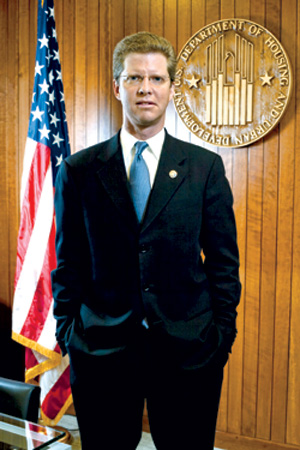
Shaun Donovan last month in his office at HUD headquarters in Washington, D.C.
Shaun Donovan was in a car headed to a luncheon at the Marriott Marquis with three colleagues when his phone rang with the news that Barack Obama wanted him as the nation’s chief housing czar.
All three coworkers were unaware that their boss, then-commissioner of the city’s Department of Housing Preservation and Development, had met secretly with Obama in Chicago to discuss the job. So, after hanging up the phone, the famously exuberant policy wonk had to hide his excitement and pretend nothing had happened.
“I waited until they got out of the car to celebrate,” Donovan remembered, in an exclusive interview with The Real Deal last month. Then he turned to his longtime friend and driver, John Dees, and gave him a hug.
The acting wasn’t over. Once in the Marriott, Donovan coolly accepted an award and addressed a crowd of 1,000 guests at the annual New York Housing Conference luncheon. Then he nonchalantly dropped the bombshell on the Mayor as they walked off the stage together.
“He knew that I was being interviewed, so it wasn’t a complete surprise, but he was enormously proud,” Donovan said.
Four days later, then-President-elect Obama revealed Donovan’s nomination as Secretary of Housing and Urban Development to the rest of the nation during his weekly radio address.
And from there, the real work began.
Arriving in the midst of the worst housing crisis in generations, Donovan has been at the center of the fight to staunch a historic flood of foreclosures, revamp the nation’s housing policy, shore up government-chartered mortgage giants, and push tight-fisted bankers to work with struggling homeowners on loan modifications. That’s on top of wrestling down an agency notorious for corruption and bloat, and doling out the largest stimulus package in decades.
Despite all this, Donovan still crows about “his dream job.”
Few who know the 44-year-old New Yorker are surprised.
“If you hear him talking about housing issues, you know he really cares,” said Martin Dunn of the Dunn Development Corporation, who worked with Donovan when he was commissioner of HPD. “He works from early in the morning until late at night.”
During the interview last month, Donovan talked about the challenges of his new job and offered details of life in Washington, from cabinet meetings to Ping-Pong with the president.
But the question many in the city’s real estate world are asking is: What does it mean to have a native son running the nation’s housing policy? To hear Donovan tell it, the Obama administration is intent on launching a fundamental transformation in the relationship between the federal government and the nation’s cities — one that will have profound consequences for New York.
“This is an urban administration; in many ways, the most urban administration that we have seen,” Donovan said, noting that Obama has lived in Chicago, Boston, Los Angeles, Washington and New York. “Cities ought to take comfort that we will be a very different partner to them on the federal level than they have seen in a generation.”
Aside from the current recession, the challenges many cities face have more to do with economic vitality than blight: How do you preserve and create affordable housing when neighborhoods are growing increasingly gentrified? How do you prevent public housing from being ghettoized? How do you knit an urban landscape so that real estate, education and transportation complement one another?
Molded in New York
That’s a different set of challenges than those faced by the divided New York that Donovan grew up in.
A son of the Upper East Side who attended its elite Dalton School, at age 11, Donovan was sitting in Yankee Stadium during the 1977 World Series when Howard Cosell wearily intoned: “Ladies and gentlemen, the Bronx is burning.”
Cosell’s quote, made as ABC broadcast footage of a building on fire a few blocks away, came to symbolize the downward spiral of cities nationwide. That deterioration made a deep impression on Donovan.
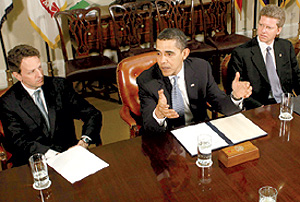
Donovan (on far right) with President Obama and the U.S. Secretary of the Treasury, Timothy Geithner.
But then, so did the city’s resurrection.
“The South Bronx of today is unrecognizable from the South Bronx I remember as a child,” Donovan said. Its transformation, he said, was due to “the courageous intervention of the local government, and the involvement of the private and nonprofit sectors, and that holds lessons that could benefit the entire country.”
It would be a couple of decades from that night at Yankee Stadium before Donovan was in a position to put those lessons to use.
After graduating from Harvard with an engineering degree in 1987, he earned two master’s degrees, also at Harvard — in architecture, and in public administration at the Kennedy School of Government, where he discovered housing policy.
His first housing-related job was at the Community Preservation Corporation, a nonprofit lender and affordable housing developer in New York. He then joined the Clinton Administration in 1998 as a special assistant. Within 16 months, he rose to deputy assistant secretary for multifamily housing.
When he returned to New York after Clinton left office, Donovan took a visiting scholar position at New York University before joining Prudential Mortgage Capital Company in 2002 as a managing director of FHA lending and affordable housing investments.
Donovan’s combination of public, private and nonprofit experience made him an obvious candidate when Mayor Bloomberg tapped him to take over as HPD Commissioner in 2004.
The Mayor vowed to create or preserve 165,000 units of affordable housing by 2013 — in the midst of a real estate boom. By 2006, the New York Times noted, Donovan was “seen nationally as a pioneer in finding new ways to create and preserve low-cost housing.”
Robert Lieber, the city’s deputy mayor for economic development, pointed to Donovan’s creation of the New York City Acquisition Fund as an example of his ability to “get things done in nontraditional ways.” The fund was established to help nonprofits and smaller developers eager to create affordable housing, but unable to obtain funding.
Donovan raised $34 million in private foundation funding, along with $8 million in city money, to serve as a “guarantee pool” that would secure larger loans. Then he approached banks and other major financial institutions, and convinced them to kick in close to $190 million to finance development.
Donovan’s embrace of inclusionary zoning was another signature issue. For years, advocates had been lobbying the Bloomberg administration to allow developers to exceed zoning restrictions if they agreed to devote a portion of their excess units to affordable housing.
But the Department of Planning, remembers one industry player around at the time, “always used to say, ‘zoning is about land use, it’s not about social goals.'”
Donovan came in with a fresh eye, said New York City Council Member Brad Lander, who was the director of the Pratt Center for Community Development at the time.
He embraced inclusionary housing, while making clear from the start that mandating developers to include affordable housing, a stance favored by some advocates, “was not going to fly in the Bloomberg administration.”
Instead, Donovan pushed for a voluntary policy, one that many advocates could support, but that would allow him to also win the backing of developers and get through the zoning board.
While the mayor has since revised his plan, extending it an additional year and placing more emphasis on preserving units, by September 2008, just a few months before Donovan left to join the cabinet, the city was halfway toward its goal, financing 82,500 affordable housing units.
Arriving in D.C.
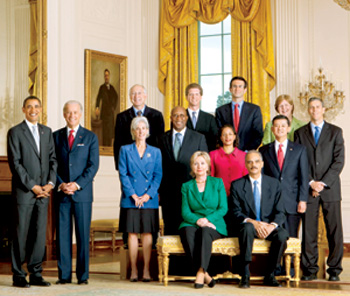
Donovan (back row, second from left) with some members of President Obama’s cabinet.
Now, after years of working in the housing world, Donovan has arrived in Washington to find a wonky policy partner in President Obama, whom he says he meets with a couple times a week.
The President, he said, shares his passion for housing issues, having cut his teeth as a community organizer fighting for housing on Chicago’s South Side.
“From the moment I interviewed with him,” Donovan said, “I got a sense of his fairly deep understanding not just of what housing means to people in communities, but that he actually understood the mechanics of how the real estate markets work, and how affordable housing transactions get done.”
Donovan and Obama share another bond — each of Obama’s daughters is one year older than Donovan’s sons, Milo and Lucas. Last month, Donovan’s wife, Liza Gilbert, a landscape architect, and their two sons accompanied him to the White House for a Super Bowl party.
“One of my sons got to play Ping-Pong with the president,” Donovan said.
Despite such heady surroundings, Donovan hasn’t forgotten where he came from. His family continues to live in Boerum Hill, Brooklyn, while Donovan travels home to see them most weekends. He’s also on the phone conferring with Mayor Bloomberg and other city officials several times a week. Donovan said he’s attempting to apply a number of lessons he learned in New York to the national stage.
High-profile challenges
Of course, many of the most high-profile challenges Donovan faces now have little to do with the kind of problems faced by a big-city housing commissioner — or even by any previous HUD Secretary.
As the administration’s housing czar, Donovan has played the role of a key spokesperson for many of the White House’s signature housing rescue efforts, some of which are turning out to be controversial. Many of Donovan’s most high-profile public appearances last year, for instance, touted administration initiatives aimed at encouraging banks to offer homeowners loan modifications, such as a $75 billion program known as the Home Affordable Modification Program.
Donovan has been one of the program’s most vocal salesmen, testifying in front of Congress and pressuring loan servicers to “ramp up their efforts” to modify loans.
But a year after HAMP was unveiled, a growing number of critics are complaining that the modifications are simply delaying foreclosures for homeowners and allowing banks to continue to put off an honest accounting of their losses.
Donovan is also grappling with another lightning-rod issue: the fact that the Federal Housing Administration, which is part of HUD, is in tough financial straits, a reality some contend the administration did not see coming soon enough.
Last fall, the administration acknowledged that 20 percent of loans insured by the FHA in 2008 alone are facing serious problems, placing the agency in danger of needing a government bailout. As a result, in recent months, the agency has increased premiums and raised down payment requirements for borrowers with low credit scores, to try to shore up its financial condition.
Meanwhile, Donovan also has his hands full as the government representative on the board of the government-sponsored mortgage giants, Fannie Mae and Freddie Mac, which have been in financial crisis for months.
The handling of Fannie and Freddie by the administration has provided ammunition for some conservative critics. Howard Husock of the Manhattan Institute said: “It would be nice if [Donovan] were playing a stronger role in offering a view on what their long-term role is in the American housing market, and how we can extricate ourselves from this situation, in which we are investing billions and billions into what are now essentially bankrupt enterprises.”
Donovan and the Obama Administration have promised a plan is forthcoming in the weeks ahead.
A new focus
Despite these challenges, few directly attack Donovan — even Husock noted that “compared to previous HUD Secretaries, Shaun Donovan is really a very, very capable guy. He’s technically capable, understands numbers and has tremendous experience with public finance.”
In fact, in many areas, Donovan is already making the kind of impression he made in New York — as an energetic and creative force.
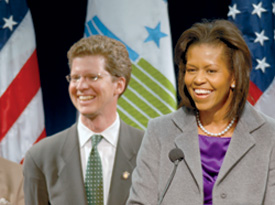
Donovan with First Lady Michelle Obama at a meeting with HUD employees.
Though not as high-profile as shoring up the mortgage crisis, Donovan “has reinvigorated the core mission of HUD, which is to promote affordable housing opportunities,” said Doug Rice, a housing policy expert at the Washington D.C.-based Center on Budget and Policy Priorities.
“Part of that is rebalancing federal policy to place more emphasis on affordable rental housing, which has been sadly neglected in recent years,” Rice said.
That’s a major change from the priorities of the Bush Administration’s three HUD Secretaries, all of whom pushed for more home ownership.
But Donovan said he sees rental and multifamily housing as a key element to any solution to the current mortgage crisis, and he has focused much of HUD’s energy in that area.
“We haven’t really had a rental housing policy at the federal level,” said Donovan. “Our national housing policy has been focused on home ownership to the exclusion of multifamily housing.”
New York got its first hint of what Donovan’s new emphasis could mean last year, when Congress passed the massive stimulus bill. The Federal Recovery Act, which went into effect last February, included $14 billion in funds for rental housing. The New York City Housing Authority snared the largest single portion of that, about $423 million.
The inclusion of that level of funding electrified public housing supporters.
New York has since scored more grants, and “that’s partially because of New York City’s relationship with Shaun Donovan,” said David R. Jones, president and CEO of the Community Service Society, a New York nonprofit group that works on housing issues.
The stimulus bill, for instance, contained money to help municipalities buy abandoned properties in neighborhoods hit hard by foreclosure. Originally, New York was ineligible for the funds because they were earmarked for single-family homes. But Donovan expanded the program — and New York City won $20 million.
“The secretary was very involved in constructing the parameters of that program to reflect the evolving nature of the foreclosure crisis,” said Rafael Cestero, New York’s current HPD commissioner and a former Donovan deputy. “In many cities, three-, four-, five- and even 10-unit buildings were starting to fall into foreclosure. Making them eligible helped us.”
There should be more of that aid to come.
The recently unveiled 2011 federal budget outlines five key areas of focus for HUD. Only one of those areas is directed at single-family home ownership, which played such a prominent role in the current housing crisis.
The rest focus on issues like public housing, homelessness and “meeting the need for quality affordable rental housing.”
Conrad Egan, president of the National Housing Conference, a D.C.-based affordable housing group, praised the budget, and noted that “there was obviously a thought process that went into it.”
“This is a new day,” he said. The budget is “built around real goals and strategic planning for a change, rather than a laundry list of themes.”
Overall, the White House’s budget request for HUD is $41.6 billion — down about 5 percent from last year’s request, in keeping with the administration’s guidelines not to increase funding for domestic discretionary programs. But despite those restrictions, it requested a $1.4 billion increase in tenant-based rental assistance, and a combined $1.8 billion jump in project rental assistance and Section 8 renewal funds.
Perhaps more significantly, the administration has a new policy called “Transforming Rental Assistance,” aimed at cutting through red tape and using some of the innovative financing techniques Donovan pioneered in New York. A key component of the plan seems simple enough: Stabilize funding for subsidized housing units so that it seems they will remain financially viable. Then allow public housing authorities to seek outside investors or borrow from banks.
Such simple tweaks seem like Finance 101, but in the bureaucratic world of public housing, they are revolutionary.
The funding stream will allow local housing authorities to “leverage and access private capital,” Donovan said, similar to the way he did in New York.
Realizing results
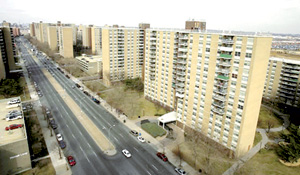
HUD was instrumental in the deal that Starrett City finalized to keep the entire complex in the Mitchell-Lama affordable housing program for the next 30 years.
The new tone Donovan has set since he took over in January 2009 has already paid off at some of New York’s largest apartment complexes, including Starrett City in Brooklyn, the largest publicly assisted affordable housing complex in the nation.
In December, the owners of Starrett City finalized a deal to keep the entire complex in the Mitchell-Lama affordable housing program for the next 30 years, and set aside tens of millions of dollars for capital improvements. In exchange, they are guaranteed Section 8 housing subsidies for the next 20 years, and they completed a $531 million refinancing guaranteed through Freddie Mac.
The deal required special Congressional legislation, along with state and city backing. It also required HUD “to sign off on every document,” said Alan Wiener, who originated the refinanced loan as managing director of Wells Fargo’s Multifamily Capital division.
Donovan “clearly set the tone at HUD” that would carry through the deal, Wiener said.
“On the affordable side there has been a huge improvement in terms of the way the money comes in and the flexibility they show,” Wiener said.
“Donovan has been a huge advocate for multifamily, which has kind of been unheard of recently.”
Steven Spinola, president of the Real Estate Board of New York, said “We believe [HUD] has more than doubled its financing for both market-rate and affordable housing in the last year or so.”
Donovan’s presence in Washington has proved useful to the real estate industry here in other ways, too. For months, developers have been battling buyers looking to break contracts by seizing on an obscure federal law called the Interstate Land Sales Full Disclosure Act. ILSA requires that developers who divide land into 100 or more parcels register a report with HUD.
The law was intended to protect out-of-state consumers from being swindled into buying worthless tracts of land in subdivisions.
Spinola told The Real Deal he contacted Donovan to discuss it. “I called Shaun right after he got there and he made arrangements for myself and an attorney to go down and talk to his people, and we sat down and laid out the issues,” Spinola said. “There has been open dialogue.”
Of course, the last HUD Secretary from New York City — Andrew Cuomo — is currently considered a front-runner in the upcoming gubernatorial election.
Could a similar path lie ahead for Donovan?
“I have my dream job,” Donovan said. “And I’m not doing any thinking beyond being the best HUD secretary I can be.”
